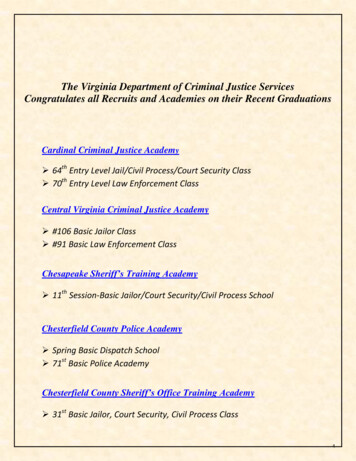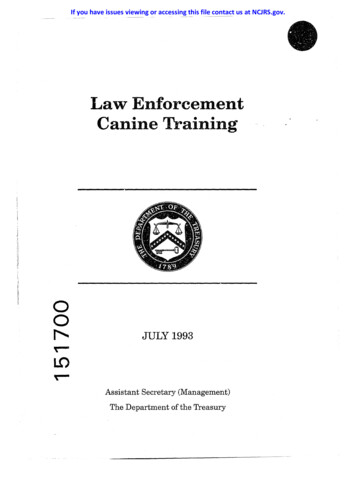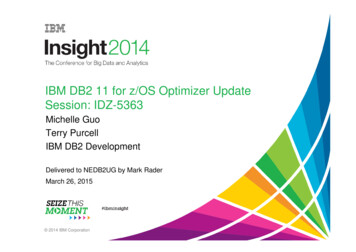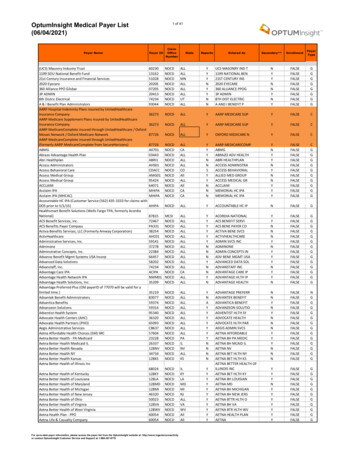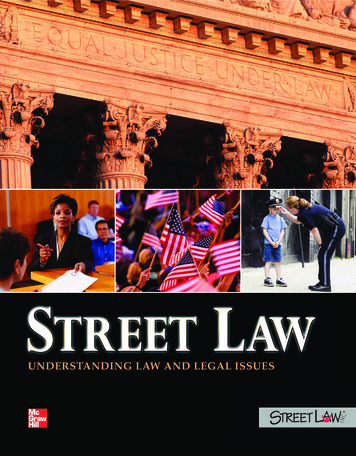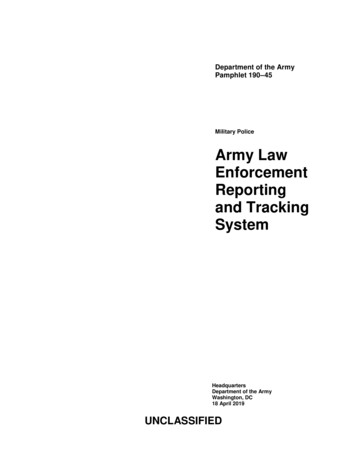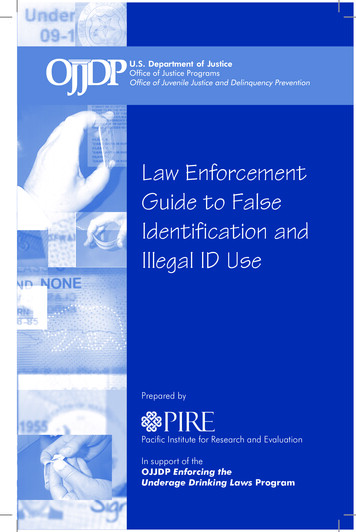
Transcription
Law EnforcementGuide to FalseIdentification andIllegal ID UsePrepared byPacific Institute for Research and EvaluationIn support of theOJJDP Enforcing theUnderage Drinking Laws Program
This project was funded by the Office of Juvenile Justice andThis project wasfunded byJuvenile UnderageJustice andDrinkingDelinquencyDelinquencyPreventionas thepartOfficeof its rinkingLawsprogramLaws program (Award number 98-AH-F8-014).(Award number 2009-AH-FX-KOO1).This guide was originally written by Lieutenant David Myers of theThis guidewas originallywrittenby LieutenantDavid Myersof theFloridaDivisionof AlcoholicBeveragesand agesandTobacco,CaptainMarkWillingham of the Center for Tobacco and Alcohol Access PreventionWillinghaminofJacksonville,the Center nStewartofPreventionthe Pacific(C-TAAP)Jacksonville,Florida andNewKathrynStewart oftheaddedPacificInstituteforinResearchand aluation.Newinformationwasaddedto this document by staff and trainers from the Underage Drinkingtothis documentTrainingby staff andconsultantsfromInstitutethe UnderageDrinkingEnforcementCenterat the Pacificfor ResearchandEnforcement Training Center at the Pacific Institute for Research andEvaluation.Evaluation.The opinions expressed here are those of the authors and do notnecessarilyreflectthe officialpositionor thepolicyof theandU. doS. DepartmentThe opinionsexpressedhere arethose ofauthorsnotofJustice. reflect the official position or policy of the U.S. Department ofnecessarilyJustice.Published February 2001.Original Publication: February 2001.Updated September 2011.Updated September 2011.This publication was updated by Scott Friedlein May 2011
Calverton Office Park11720 Beltsville Drive, Suite 900Calverton, MD 20705Toll Free: 1-877-335-1287www.udetc.org
The Underage DrinkingEnforcement Training Centerwww.udetc.org
ContentsOverview.1How to Use This Guide.3False Identification (Fake ID)Issues and Strategies to Prevent Underage Alcohol Use.4How Do Young People Obtain Fake IDs?. 6What Are the Typical Types of False or / Illegal IDs?. 7What Can Be Done to Curtail the Manufacturers of FalseIdentification?.13What Can Retailers, Servers and Sellers Do to Prevent Sales toPersons Under 21 Using False IDs?.18What Can Communities and Law Enforcement Do To Reducethe Use of Illegal IDs?. 22What can be done at the State level to assist in reducing illegalID use?. 25Conclusion.28
OverviewPost 9/11, states and territories have been tasked with developingmore secure identification. Many discussions focused on creating anational identification. The end result to these discussions have beenthe development of many security measures and the production of highquality advanced IDs whose overall design make it more difficult toreproduce. With many advanced security features, states have chosenthose features that they feel will help them the most in preventing themanufacturing of illegal documents.Despite these efforts, young people still find a way to create fraudulentand fictitious documents and use illegal IDs. The internet is full ofresources available to savvy people willing to risk much to produce theseillegal documents. While states try to maintain the secrets of their IDsyoung people are dismantling the document and sharing informationdiscovered. With a few key strokes on the computer the information maybe obtained. A person wanting to obtain a fake ID can find resources toguide them in the creation of their own fake ID, or templates providingexact information on the desired document as well as actual sites that arewilling to sell them a fake ID.Beyond the world of fake IDs are people who are willingly providingtheir own identification to others for illegal purposes. In many areas ofthe country and commonly in college communities this form of illegalID use is far more common than the use of the fraudulent or fictitiousdocuments.The ability for youth to access alcohol is only one of several problemsthat are occurring as a result of illegal ID use. Cases have beendocumented where a young person is admitted to a hospital under thewrong information. Notifications to parents have occurred only tofind out later that it was not their child. People have been arrested andbooked in under false ID names. Identity theft and fraud often have afake ID aspect to them.
Law Enforcement Guide to False Identification and Illegal ID UseThis guide is intended to provide law enforcement officers’ informationon the prevalence of illegal ID use, information on common securitymeasures and tools used to detect them as well as steps for checkingIDs that increase the likelihood of detection. Information will also beprovided on working with retailers to help reduce illegal ID use in theirown community. 2
How to Use This GuideThis guide is intended to acquaint law enforcement officers with thevarious ways in which false identification can be created, as well asthe current technologies for designing identification to thwart forgeryor alteration. It describes the techniques and tools that can aid indeterring or detecting false identification use. This guide, when used asa companion to commercially available ID reference booklets, can be apowerful tool to aid in the detecting of illegal IDs and deterring youthaccess to alcohol.Law Enforcement officers can use this publication to: Assist in determining if a form of identification is legitimate; Assist in training law enforcement officers in methods used toidentify false and fraudulent forms of identification; and Provide retailers with guidance in detecting false IDs.This document contains sensitive information and is intended for use bylaw enforcement and community elements who engage in ID checking aspart of their job functions.
False Identification (Fake ID)Issues and Strategiesto Prevent Underage Alcohol UseStates and communities all over the country are concerned aboutalcohol use by persons under 21 and are involved with actions to helpprevent underage drinking. They recognize that alcohol is the drugmost commonly used by young people and that it is an all-too-frequentcontributor to injury, death, and criminal behavior among youth.Fortunately, much progress has been made.The most effective strategies focus on restricting underage access toalcohol, especially retail sales to persons under 21. One common waythat young people have of obtaining alcohol is to purchase it in stores orbars. Many communities are cracking down on sales to persons under21 by implementing vigorous enforcement campaigns to ensure thatretailers ask for age identification of young customers and refuse salesto those who are underage or who cannot produce proper identification.These campaigns have been shown to be extremely effective in reducingsales to persons under 21.As success has been seen with enforcement programs like compliancechecks, youth have continued to look for ways to gain access to alcohol.The use of illegal IDs appears to be a growing means by which theygain that access. In many areas the most common means of illegal IDuse is through the use of borrowed legitimate IDs. Some communities,who track this use, report borrowed IDs being used up to 95% of thetime. This is an important fact to keep in mind especially as it relates totraining the retailers in the community. Emphasis must be made on thevalidation of the document and the comparison to the user.Government entities have continued to improve the security features ofIDs and altering those documents has become more difficult. Tactics foralteration have included the use of super glue or fingernail polish to alter
5 Law Enforcement Guide to False Identification and Illegal ID Usebirth dates, false fronts placed over the ID and attempts to change thephotograph.Despite that positive outcome of the improvements in the legitimateIDs, manufacturers of illegal IDs have continued to stay abreast ofthe changes and work to produce good quality illegal documents.Creative college students and individuals with criminal intent have beenextremely good at developing the “fake” document. We are fortunatein that the changes being made to the real documents are such that toproduce a nearly equivalent fake ID has become relatively expensive.The overall benefit of this has been a reduction in the casual false IDmanufacturer.It is important to realize that illegal ID use has multiple ramificationsand does not solely relate to the obtaining of alcohol. Cases have beendocumented where individuals using illegal IDs have been admitted tothe hospital using the wrong ID which created a significant risk to thepatient. In other cases the wrong parents were notified following anincident. One of the most common risks and outcomes of illegal ID useis identity theft. Young people purchasing an ID through direct contactor via the internet are often asked for personal information. Theirdesire to obtain that illegal document may cloud their judgment and theywillingly provide their personal information. The risk that the “fake” IDmanufacturer will later use that information for personal criminal use isgreat.This booklet will provide information on the various types of illegal IDsbeing used, techniques for detecting illegal IDs, information on someof the more common security features, questioning tactics for retailersand steps for working with the industry. It will also discuss policies thathave been effective in reducing illegal ID use and legal strategies usedby some states that have aided in the detection and processing of subjectsusing Illegal IDs.
Law Enforcement Guide to False Identification and Illegal ID UseHow Do Young People Obtain Fake IDs?Young people have many potential sources of fake IDs. As mentionedabove, one of the most common is the borrowed ID which is obtainedfrom an older sibling or friend who is willing to lend or give their ownID to an underage person. In recent cases, college students involved instudent organizations, upon graduation, leave an ID behind with thatorganization to be used by others or friends of the organization. Thestructure within student organizations has helped produce a regularstream of “borrowed” documents. In some cases employees of retailersare a primary source of the borrowed ID with the employee obtainingthe ID from the retailer without the owners or managers knowledge. Apotential underage purchaser can usually count on the fact that any IDwill not be closely inspected by a store clerk or alcohol server.If they want a more convincing ID; however, they do not usually haveto look far. The internet, for example, provides numerous websitesthat; provide instructions on how to manufacture their own illegal ID,provides the templates for government IDs which can be easily changed,sells the manufacturing components to produce the illegal ID or, sellsdirectly the illegal ID with the click of a mouse. Sometimes, creativeindividuals become traveling merchants out of their vehicles or hotelrooms, advertising on the internet or spreading fliers throughout acampus or community advertising their wares.With the large amount of information available via the internet youngpeople, in some cases, will learn how to use available scanning, printingand copying technologies to manufacture false identification. Withadvanced technology of computers and similar equipment the quality ofthe fake ID has improved making distinguishing of genuine license froma false ID more difficult. 6
7 Law Enforcement Guide to False Identification and Illegal ID UseWhat Are the Typical Types ofFalse or / Illegal IDs?False / Illegal IDs fall in into three categories: borrowed, fake(fraudulent), and altered.BorrowedThe most common form of illegal ID in use today is the borrowed ID.Persons under 21 will often borrow identification from those who canlegally drink. The source may be siblings, friends or IDs obtainedthrough friends where the owner of the ID is unknown to the user. Insome communities where illegal ID use has been tracked (ChampaignIL, San Diego CA) the borrowed ID has accounted for between 85% and97% of all illegal ID use. While the possibility of use of a siblings IDexists, it is more common for the borrowed ID to be a subject not relatedto the user. Information from licensing organizations has revealedalarming trends in the obtaining of duplicate driver’s licenses and IDcards by person age 21 to 25. In some cases it’s been documented that asingle individual has needed to obtain 4 to 5 replacement IDs. Do youthink it is coincidence? Knowing this should help guide individualsinvolved in carding.Techniques for detecting the borrowed ID may include: Examination of the ID to include close scrutiny of the ID photoas compared to the user. It is suggested that scrutiny start withidentification of permanent facial characteristics of the user andthen a comparison to the photo. Hair color, facial hair, hair styleand eye color should not be primary focal points as these can beeasily changed. Review and comparison of other physical descriptors like heightand weight. Validation of ID (Is it an acceptable form, is it expired, or is it aduplicate ID?)
Law Enforcement Guide to False Identification and Illegal ID Use Questioning the holder of the ID to determine if in fact it isthem.If aspects of the ID create a concern to the person carding, the next stepis to question them about the information on the ID. When questioningsubjects it is important to realize, in borrowed ID cases, that the useris likely to have memorized the information. To be successful in thecarding process it is important for the questioning to be done in a waythat would create a reaction of deceit. Signs of deceit may includeavoiding eye contact, unusual hesitation, nervous behavior, attempts tointimidate and the eyes tracking up (recall or making something up).Most questions asked about the ID would not require the owner touse recall. In cases where the borrowed ID has been presented it isimportant for the carder to display confidence and ask questions in a waythat would create the need for recall. During the questioning phase it isnot uncommon to ask the user to recite the address. This can be donewith little challenge to the user. However, if the carder were to ask forthe house or apartment number instead of the address it is much morelikely to result in a reaction indicating the user is not the owner. Havingthe user spell the first or last name can also result in the detection ofillegal ID use. When spelling their own name a person will typicallydevelop a rhythm and give emphasis to certain letters. The user of a fakeID will typically be more rigid and monotone in the spelling of the namebecause they don’t take ownership of the name. It is also not uncommonfor the user to misspell the name.Creative questioning can also help in detecting the borrowed ID. Askingquestions like what is your middle name and prompting them with thewrong middle initial can result in a deceptive response. The responsemay include the providing of a middle name using the prompted forwrong middle initial. It may also include a lack of care or concern aboutan error in the document, again showing a lack of ownership. Mostpeople would express a great deal of concern over an error in theirdriver’s license or ID card. Another type of creative question would beto ask for the year of graduation. This question will typically require theuser to do the math to come up with the correct year. Signs of deceit will8
9 Law Enforcement Guide to False Identification and Illegal ID Useinclude unusual hesitation and the eyes tracking up.Another technique in detecting the borrowed ID is to have the user signtheir name on a piece of paper. It is recommended that the user signthree times. This allows the carder to watch how the signature is beingdone. Typically, people using the borrowed ID will be very slow anddeliberate in signing the name and will make an effort to emulate theprevious signature. The signatures are then compared to the signatureon the presented documents. In most cases the carder does not needto have any training to detect the differences, they are usually veryapparent to include the wrong slant and misspellings.When discussing fake ID use it is not uncommon for there to be a lackof recognition of this form of use. As stated earlier, the borrowed IDsare the most common type of illegal IDs being used by people under 21.Communities should be encouraging retailers to be alert to this type ofuse and be aggressive in their carding efforts. Law Enforcement shouldalso be supporting these efforts to help reduce youth access to alcohol.Fake / Fraudulent / Fictitious IDs –Fake, Fraudulent and Fictitious IDs are documents that purport to bea driver’s license or ID card. Some of these documents may appear tobe a real ID as issued by a government entity while others may have nosimilarity to the documents being issued but are designed in such a waythat a person may believe them to be a real document. In the majority ofthe cases, with close examination and the use of an ID checking guideand other detection equipment, fake IDs are detectable. The cardersknowledge of IDs commonly used in the area will also help greatly inthis detection. Communication between retailers and law enforcementand the sharing of information on what IDs each are seeing will help.Fake IDs come from a variety of sources. Creative individuals haveestablished their own ability to produce and market their own fakeIDs and provide or sell them to friends and acquaintances. In somecases the qualities of the IDs produced are good enough that theyexpand their business and sell them through referrals and their ownmarketing efforts. The availability of fake IDs through the internet is
Law Enforcement Guide to False Identification and Illegal ID Use also abundant. A quick computer search on the term fake ID revealsmillions of hits. Some of the sites listed advertise novelty / fake IDsand sell their products through the online purchase process. These IDsare of good quality and can pass for real state documents if the carderfails to examine them closely. To avoid prosecution some of these IDshave disclaimers that they are not real documents or not issued by thegovernment. In these cases the manufacturer tells the user that he or shebears the responsibility for the illegal use.Buyers beware. Some internet sites are scam based. People arewillingly sending money to these sites with hopes of getting an ID.After sending in the money and information they anxiously await thearrival of the ID only to realize that they have been scammed. It isnearly impossible to tell the difference between these types of sites whenthey are posted online. It’s only after the purchaser goes back to look forthe site that they realize they have been scammed.The easiest way to detect the majorityof these IDs is the visual and physicalexamination of the actual document. Thecarder must get the ID in hand to be ableto feel it and properly examine it. Therefour basic “feel” tests that will aid in thisdetection. The first is to check the rigidityof the card. In many cases the material the Fake ID is produced from isof a different weight / thickness than the real document. Simply givingthe ID a squeeze, as shown in the photo to the right, will help you makethat determination. The weight of the document will vary from state tostate but will be consistent with in the state and the style of ID beingexamined.The second test involves checking the edgesof the ID. Most all IDs have rounded edgesdue to the material they are made from. Ifthe edges feel square it is possible the ID hasa false front. If the edge feels square a closerinspection should be completed. Typically10
11 Law Enforcement Guide to False Identification and Illegal ID Usethe squared edge is due to an overlay affixed to the front of the ID. Thisoverlay is cut incorrectly and creates the squared edge.Feeling the front and back surfaces should also be done as part of the“feel tests”. Carders should, using the pads of the fingers, lightly feelfor bumps, ridges and irregularities that are not part of the normal ID.Some states are now using raised ink and embossed print as part of theirsecurity features. The raised ink feature may include signatures andbirth dates printed on the front and back. The embossed feature mostcommonly uses the birth date. These raised characters can been seenand felt. A photo example of the embossed birth date is provided in thesection on security features.The last of the “feel” tests is to check thecorners of the ID. Real documents are madein such a way that the face of the ID cannotbe peeled up. To check this, the carder cansimply try to split the ID using a fingernail.If the ID splits it is a good indicator that thedocument is not real. It is not uncommon tofind young people using false front IDs. The texture of the false front is,at times, different. IDs users reluctant to remove IDs from carriers maybe using this technique.It is important to conduct a visual examination of the ID as well. Thisshould include checking the overall appearance of the ID as well as thefonts and coloration patterns. It is not uncommon to see font differencesbetween fake and real documents. This may include a totally differentfont style, improper bolding, lack of shading and the wrong size font.The colors may be of different shades or even the wrong color for thetype of ID being shown. Spelling errors have also been noted on fakeIDs.Many fake IDs have their own security features which are inconsistentwith the real documents. They may have symbols on them which arecommon to fake IDs. A seal of authenticity, eagle’s head or flyingeagles, skeleton keys, whole globes or three part globes and words like
Law Enforcement Guide to False Identification and Illegal ID Use secure, valid and genuine have been regularly placedon the security plate of the fake IDs. It is importantto know what should be appearing on the face of theID. Again, the use of a ID checking guide can be veryuseful in making that assessment.When doing the visual examination ofthe ID, carders should always rememberto examine the back as well. Thosemanufacturing illegal IDs go to agreat deal of effort to try to match theface of the ID but often fail to put thesame effort onto the back. The reverseside of the ID may have informationwhich does not even match the real document. In some cases themanufacturer will put information on the back designed to convince theperson examining it that the document is real (“Card Credibility StatusDefined”). While the document may look good, the fine print tells adifferent story. In some cases, they will also embed statements like “Nota Real ID” or “Not a Government ID” on the back.When law enforcement encounters these types of cases it is importantto question the possessor as to how they obtained the fake ID. A sourceinvestigation may be called for when information is received that pointsto local or regional manufacturing activities.Altered IDsAltered IDs involve making physical changesto a real ID. This most commonly involvesthe changing of the birth date or photo.With the improved security features on IDsissued by the government, the alterations ofthese documents have become less frequent.Current trends involve only the changing of the birth date and relateddate information like “Under 21 Until”. With newer style IDs the abilityto change the photo has been eliminated.12
13 Law Enforcement Guide to False Identification and Illegal ID UseA common technique used to alter birth dates involves using clearfingernail polish or super glue. The polish or glue is placed directlyover the numbers to be changed and a new number is then placed onthe polish or glue. This will usually result in a small raised spot overthe year of birth and in some cases a shiny spot in that same area. Thisalteration can be detected using the “Feel Tests” mentioned above. Avisual examination will also reveal coloration changes in the numberswith some areas being darker than others. Fonts may also be different.What Can Be Done to Curtail theManufacturers of False Identification?Vigorous pursuit and prosecution of the manufacturers of falseidentification is uncommon. The nature of the laws againstthis behavior, the relative ease of manufacture, and the fact thatmanufacturers are often located out of state or in foreign countries makeenforcement difficult. Many states have reacted to the difficulty incriminally addressing the manufacturing process by making significantchanges in the IDs the States are producing. Because the status ofapplicable laws vary from State to State and can change over time, itis recommended that you check the statutes in your State annually forchanges and/or consult with your legal advisor for changes in your statelaws. The advancement in security features make it more difficult forthe manufacturer by adding layers of security requiring more effort onthe manufacturer’s part. Some of the common security features areshown below. The examples are being provided to highlight the effortand educate the law enforcement and retail community on what to lookfor when these security features are listed in the ID checking guides.Ultra-Violet ImagesWords, pictures and designs have been placed on the front and or backof IDs that are only visible with the use of an Ultra –Violet light source.The most advanced of these are color photos of the ID owner. MostStates have gone to the use of ultra-violet images. This has made itmore difficult for the manufacturer as it requires more sophisticatedequipment. In an effort to have a UV image some manufacturers have
Law Enforcement Guide to False Identification and Illegal ID Useresorted to using the states name printedrepeatedly across the face of the ID in ahorizontal pattern or another pattern just sothat it has a UV image on it. Some stateshad a similar pattern and used a similarhorizontal pattern when UV images werefirst used.It is best to check ID guides to confirm thepattern and location of the UV image. UVlight may also help in the overall detectionwithout relying on a specific image. IDsthat glow or appear very light in color mayalso indicate that the document is bad. Inthe example to the right the ID on the rightis bad. The coloration is due to the blacklight being used. The photo on the left imageis a correct black light image. Colorationdifferences are more easily detected whencompared to a known valid document.The above shows both aphoto based UV image (onleft) and a fake document(on right). The colorationdifferences should helpidentify the real form thefake.Micro printing/Nano printingMicro printing and Nano printing istext that cannot be read with nakedeye. This type of security feature mayappear as lines on the ID or as part ofpatterns or images. In some cases this feature is incorporated in part ofan optical variable device (OVD). Micro-print has been used for manyyears as a security feature. When examining the document without theaid of a magnifying glass the line or image will appear to have roughedges. Reproductions of micro-print will typically appear as a brokenline. The pattern of the micro-print may also be significant dependingon the state. Again, the use of an ID checking guide and state specificinformation can be very helpful in locating and validating the microprinting. 14
15 Law Enforcement Guide to False Identification and Illegal ID UseHolographic ImagesHolograms are three dimensional images that whenmoved around appear to change and jump out fromthe document. This security feature has been mostcommonly used with a state’s seal. The image willchange colors and appear 3 dimensional when movedaround. As is the case with any of the securityfeatures, not all States use this feature.Ghost ImagesThis security feature uses the standard IDphoto and reduces it in size, makes a lessclear copy of it and then places it on anotherarea of the ID. Good quality ghost imagesappear as though you can look right throughReal imageFake imagethe photo. Manufacturers of illegal IDs willoften take the standard ID photo, reduce the size and lighten the colorof it. In many of those cases you can make out full facial features. Thisclarity can be beneficial in detecting the illegal documents. Not allStates will use the highest quality ghost images so care should be usedwhen examining this feature.KinegramsThe kinegram security feature is not usedas widely here in the United States as itis in forgein countries. What makes thekinegram unique is that as the document ismoved around it will appear to be differentimages. This is similar to a holographicimage and may also appear similar to the optical variable device. Colorsand patterns will typically vary depending on the angle in which theexaminer is viewing the ID.
Law Enforcement Guide to False Identification and Illegal ID Use Optical variable device (OVD)The optical variable device or OVD issimilar to the Kinegram and Hologramin that when moved around it appears tochange colors. This security feature hasbeen combined with micro print in the example provided. In somecases the OVD feature will cover the entire face of the
Law Enforcement Guide to False Identification and Illegal ID Use 2 This guide is intended to provide law enforcement officers’ information on the prevalence of illegal ID use, information on common security measures and tools used to detect them as well as steps fo

